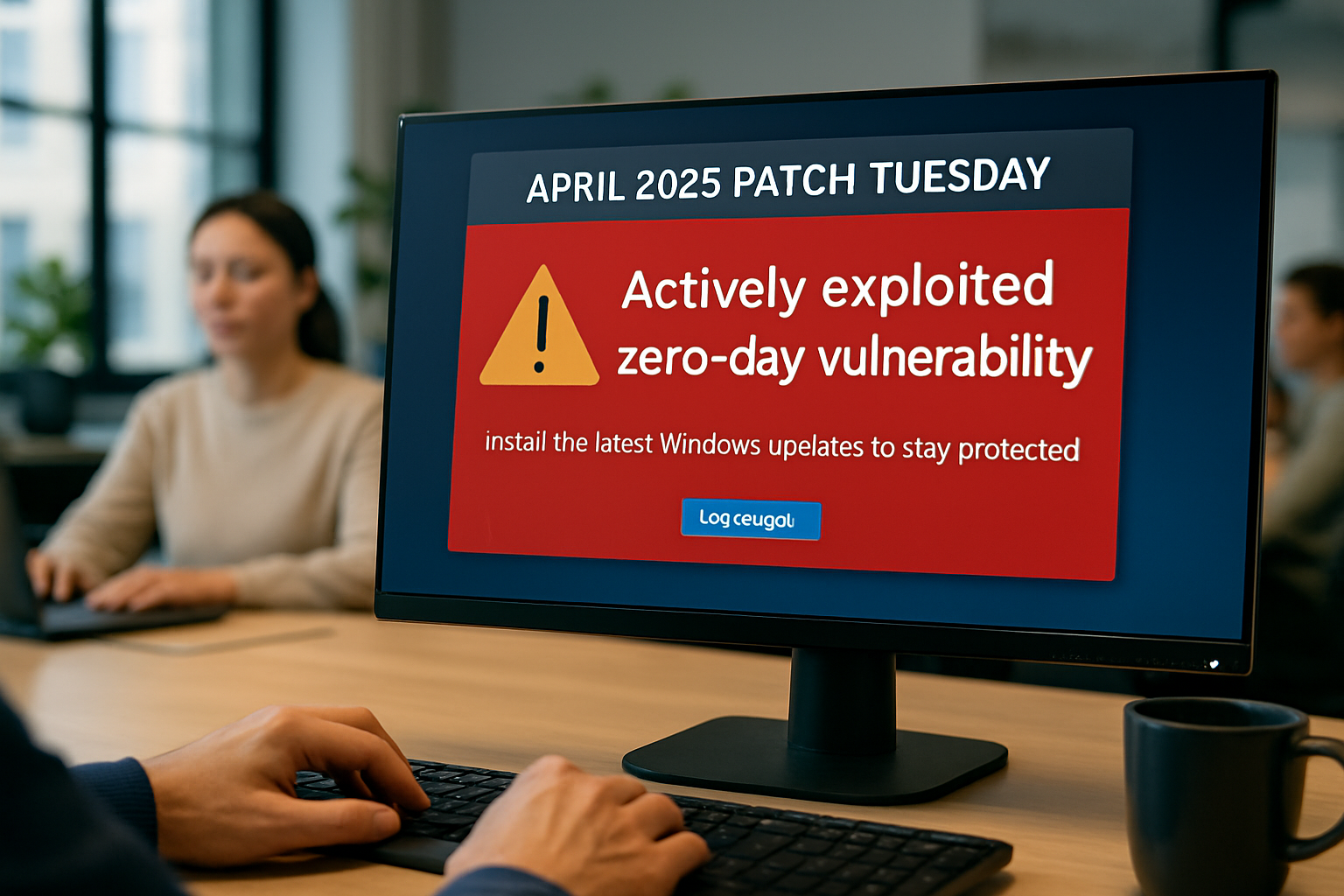Your guide to this month’s critical fixes and known issues
 Introduction
Introduction
Every second Tuesday of the month, Microsoft issues its Patch Tuesday updates—critical fixes designed to keep Windows secure and stable. April’s release was notable not only for addressing over 120 vulnerabilities across Windows and associated products, but also for plugging a zero-day exploit under active attack. At the same time, a pair of non-security regressions—the breaking of Windows Hello biometric logins and a Secure Kernel BSOD—have left some users scrambling for workarounds. In this round-up, we’ll:
- Summarize each of the three headline issues.
- Provide an at-a-glance TL;DR table for quick reference.
- Offer general advice on update management and mitigations.
- Dive deep into the history, principles, and implications of the zero-day exploit.
- Explore current trends, case studies, and future outlooks.
Whether you’re a home user, an IT professional, or simply a Windows enthusiast, this guide will help you understand what happened in April 2025, why it matters, and what you need to do next.
Brief Overview of Key Issues
- Actively Exploited Zero-Day (CVE-2025-29824)
A privilege-escalation flaw in the Windows Common Log File System (CLFS) driver was being used in real-world ransomware campaigns by the “Storm-2460” threat actor. Microsoft patched it April 8, 2025 (April 2025 Patch Tuesday: One Zero-Day and 11 Critical Vulnerabilities Among 121 CVEs, Exploitation of CLFS zero-day leads to ransomware activity – Microsoft). - Windows Hello Biometric Failures
The KB5055523 cumulative update introduced an “edge case” bug that prevents facial-recognition and PIN logins on devices with DRTM or System Guard Secure Launch enabled (Microsoft: April 2025 updates break Windows Hello on some PCs, April 2025 Patch Tuesday Update Breaks Windows Hello Login). - Secure Kernel BSOD (
0x18B)
April’s and late-March’s updates have caused “SECURE_KERNEL_ERROR” blue screens on Windows 11 24H2 systems, sometimes bricking devices until a Known Issue Rollback (KIR) is applied (Free Blue Screens of Death for Windows 11 24H2 users – The Register, Windows 11 24H2 Update Bug Triggers BSOD Error – Emergency Fix).
TL;DR at-a-Glance
| Issue | Affected Builds | Severity | Deep Dive Link |
|---|---|---|---|
| Actively Exploited CLFS Zero-Day | Win 11 24H2, Win Server 2025 | Important (CVSS 7.8) | Zero-Day Deep Dive |
| Windows Hello Login Failures | Win 11 24H2, Win Server 2025 | Moderate | Hello Login Deep Dive |
Secure Kernel BSOD (0x18B) |
Win 11 24H2 | Critical | BSOD Deep Dive |
General Workaround Advice
- Stagger Updates: Defer non-critical patches by 7–14 days via Windows Update settings to let known regressions surface before you install.
- Verify Biometric Login: After patching, immediately test Windows Hello. Have a local admin password ready if biometrics fail.
- Monitor for KIR Propagation: Ensure devices stay online and reboot within 24 hours post-patch so Known Issue Rollbacks can apply automatically.
History and Background
Patch Tuesday dates back to October 2003, when Microsoft began synchronizing monthly updates to simplify scheduling for administrators and users alike. Over the years it has become a cornerstone of Windows security, aggregating fixes for vulnerabilities across the entire ecosystem. While most months bring routine memory-corruption or information-disclosure patches, every once in a while an actively exploited zero-day slips through—most famously the PrintNightmare flaws of 2021. April 2025 joins that list with CVE-2025-29824, a CLFS driver elevation-of-privilege bug found in the Common Log File System kernel component (April 2025 Patch Tuesday: One Zero-Day and 11 Critical Vulnerabilities Among 121 CVEs, Microsoft’s April 2025 Patch Tuesday Addresses 121 CVEs (CVE …).
CLFS itself has a checkered past: since 2022, Microsoft has patched an average of 10 vulnerabilities per year in this driver, including another zero-day (CVE-2024-49138) in December 2024. Attackers favor CLFS for its kernel-mode context, which can yield SYSTEM privileges when successfully exploited. With the discovery that Storm-2460 was actively weaponizing CVE-2025-29824 in ransomware operations, Microsoft accelerated its patch release on April 8 to thwart further intrusions (Exploitation of CLFS zero-day leads to ransomware activity – Microsoft, Microsoft fixes actively exploited Windows CLFS zero-day (CVE-2025-29824)).
Core Concepts and Principles
Privilege Escalation (EoP): Operating systems enforce user-mode vs. kernel-mode separation. A successful EoP exploit like CVE-2025-29824 allows code running as a standard user to execute arbitrary kernel-mode operations, bypassing Windows security boundaries.
Kernel Drivers and Trust: Windows kernel drivers (e.g., CLFS) handle low-level tasks. They run with high privileges, so any memory corruption or logic flaw can become a serious attack vector. Attackers often chain EoP exploits with remote-code-execution flaws to achieve full system compromise.
Known Issue Rollback (KIR): Introduced in 2021, KIR lets Microsoft retroactively “undo” problematic non-security fixes without forcing users to uninstall the entire update. For both the Hello bug and the BSOD, a KIR-enabled build (e.g., KB5058919) quietly reverses the faulty change (Free Blue Screens of Death for Windows 11 24H2 users – The Register, When Updates Attack: Microsoft Windows 11’s April Patch Causing …).
Current Trends and Developments
- Rising Exploitation of CLFS: The CLFS driver continues to attract exploit development. In late 2024, ESET and Kaspersky observed PipeMagic malware using CLFS flaws as part of privilege-escalation chains (Exploitation of CLFS zero-day leads to ransomware activity – Microsoft).
- Zero-Days in Patch Tuesday: Once rare, zero-day patches now appear every few months as attackers and defenders race to find flaws in widely deployed components. In Q1 2025 alone, Microsoft remediated two zero-days across Windows and Office products.
- Increase in Regressions: With Windows gaining features like virtualization-based security (VBS) and System Guard, more update regressions emerge on devices with advanced security configurations, as we’ve seen with Hello and Secure Kernel.
- Faster Rollbacks: KIR adoption has matured; users report that Known Issue Rollbacks now propagate within hours rather than days, reducing mitigation windows for new bugs (Microsoft warns of blue screen crashes caused by April updates, Microsoft Has a Fix for Windows’ Latest Blue Screen Problem).
Applications and Implications
- Enterprise Risk Management: Organizations must balance patching speed against stability. While delaying zero-day fixes opens windows for attackers, installing updates immediately can disrupt workflows if regressions occur. Forward-looking IT teams use phased deployments and ring-based testing to manage this tension.
- Home and Small Business Users: Non-managed Windows 11 systems will automatically receive both the April fixes and any KIR mitigations. However, affected users should reboot promptly and verify biometric login, or manually uninstall KB5055523 if necessary.
- Security Operations: Incident Response (IR) teams should hunt for indicators of CVE-2025-29824 exploitation—look for unusual CLFS .blf file creations (e.g.,
C:\ProgramData\SkyPDF\PDUDrv.blf) and evidence of token-manipulation routines (Exploitation of CLFS zero-day leads to ransomware activity – Microsoft).
Challenges and Solutions
| Challenge | Solution |
|---|---|
| Rapid Zero-Day Exploitation | Enforce multi-factor authentication (MFA) to limit lateral movement; deploy Endpoint Detection and Response (EDR) rules that flag abnormal CLFS API calls. |
| Windows Hello Biometric Breakages | Re-enroll PIN/biometrics via Sign-in options; apply the KIR-enabled build (KB5055627) or uninstall KB5055523. |
BSOD 0x18B Secure Kernel Errors |
Allow Known Issue Rollback to auto-apply (or manually install KB5053656/KIR Group Policy for enterprises); reboot promptly to trigger the fix. |
| Patch Management Overload | Use WSUS or SCCM to stage updates in test rings; employ feature-based deferral policies to separate security from non-security updates. |
| Detection of In-The-Wild Exploits | Update SIEM/EQL rules to monitor for NtQuerySystemInformation abuse and suspicious RtlSetAllBits calls; integrate Microsoft MSTIC indicators for Storm-2460 campaigns. |
Future Prospects
Looking ahead, we can expect:
- More Kernel-Mode Zero-Days: As Windows’ trusted computing features grow, so do the attack surfaces in kernel drivers and hypervisor planes. Researchers will likely discover deeper flaws in new components like VBS and Secure Launch.
- Automated Update Validation: Microsoft is exploring machine-learning-powered regression detectors to catch harmful side-effects before public release—potentially reducing reliance on KIR.
- Firmware-Level Protection: Future Windows updates may leverage hardware roots of trust (e.g., Pluton, TEE enclaves) to shield critical code paths from updates entirely, minimizing the risk of kernel regressions.
- Stronger Vendor Coordination: Industry calls are growing for synchronized patch cycles among OS, browser, and application vendors to simplify dependency management and avoid “update storms.”
Case Studies / Examples
Storm-2460 Ransomware Campaigns
In early April, MSTIC and MSRC documented attacks by the Storm-2460 group using CVE-2025-29824 to escalate privileges on Windows endpoints post-initial compromise. Targets included IT firms in the U.S., financial institutions in Venezuela, a Spanish software vendor, and Saudi retail chains (Exploitation of CLFS zero-day leads to ransomware activity – Microsoft).
“Post-compromise, Storm-2460 leveraged a malicious MSBuild payload delivered via
certutilfrom a compromised third-party site, then launched the CLFS exploit in-memory to gain SYSTEM privileges.”
— Microsoft Security Response Center (Exploitation of CLFS zero-day leads to ransomware activity – Microsoft)
Enterprise Rollout in Phases
A Fortune 500 company reported catching the BSOD issue in its Ring 2 test group on April 9. By holding Ring 3 until the KIR rolled out on April 10, they avoided widespread help-desk tickets—showing the value of staged deployments (Patch Tuesday Megathread (2025-04-08) : r/sysadmin – Reddit).
Conclusion
April’s Patch Tuesday underscored the perpetual balancing act between security and stability. On one hand, Microsoft’s rapid response to an actively exploited CLFS zero-day thwarted ongoing ransomware campaigns. On the other, side-effects in Windows Hello and the Secure Kernel remind us that even non-security fixes can disrupt daily operations.
Key Takeaways:
- Immediately verify that you’ve installed the CVE-2025-29824 patch (KB5055523) and that your EDR/antivirus signatures are up to date.
- Test Windows Hello logins post-patch; re-enroll or uninstall KB5055523 if needed.
- Reboot within 24 hours so that Known Issue Rollbacks can apply automatically.
Staying secure in Windows means more than just clicking “Check for updates”—it demands an informed approach to patch management, timely testing, and proactive monitoring. Bookmark this guide, subscribe to our newsletter for future round-ups, and share your experiences below—together, we’ll keep Windows robust and reliable.
Call to Action:
- 📬 Subscribe to our Patch Tuesday newsletter for advance alerts.
- 🖥️ Share this article with your IT peers and on social media.
- ✍️ Comment below with your own post-patch experiences or questions.
- 🔗 Explore our deep-dive articles on the zero-day, Windows Hello, and BSOD issues (links at top) for step-by-step guidance.




